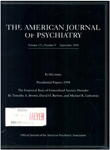Association of depression with 10-year poststroke mortality
Abstract
OBJECTIVE: Depression has been linked to higher than expected mortality from natural causes, particularly among elderly patients with physical illness. The authors examined the effect of depression on mortality among a group of stroke patients followed up for 10 years. METHOD: A consecutive series of 103 patients was assessed for major or dysthymic (minor) depression approximately 2 weeks after stroke with the use of a structured mental status examination and DSM-III diagnostic criteria. Vital status was determined for 91 of these patients 10 years later. RESULTS: Forty-eight (53%) of the 91 patients had died. Patients with diagnoses of either major or minor depression were 3.4 times more likely to have died during the follow-up period than were nondepressed patients, and this relationship was independent of other measured risk factors such as age, sex, social class, type of stroke, lesion location, and level of social functioning. The mortality rate among depressed patients with few social contacts was especially high: over 90% had died. CONCLUSIONS: These results indicate that depressed mood following stroke is associated with an increased risk of subsequent mortality. Patients who are depressed and socially isolated seem to be particularly vulnerable.
Access content
To read the fulltext, please use one of the options below to sign in or purchase access.- Personal login
- Institutional Login
- Sign in via OpenAthens
- Register for access
-
Please login/register if you wish to pair your device and check access availability.
Not a subscriber?
PsychiatryOnline subscription options offer access to the DSM-5 library, books, journals, CME, and patient resources. This all-in-one virtual library provides psychiatrists and mental health professionals with key resources for diagnosis, treatment, research, and professional development.
Need more help? PsychiatryOnline Customer Service may be reached by emailing [email protected] or by calling 800-368-5777 (in the U.S.) or 703-907-7322 (outside the U.S.).



